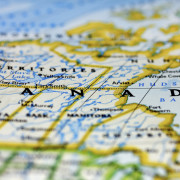A Lesson in Map-Folding Origami
Do you use maps? I’m fairly certain you do, possibly a GIS mapping app on a daily basis. When I was 16 and learning to drive maps were these sticky, dirty, impossible to fold, gigantic pieces of paper I always managed to rip while shoving back into the glove box. “You be the navigator, I’ll be the driver.” Remember those days?
Today we don’t have to worry about map origami (seriously, who actually folded it right the first time?!). I personally have 2 mapping apps on my Android, both of which have totally different purposes.
GIS Mapping Apps in order of favouritism:
1) Waze – Hands down one of the most fun and accurate traffic applications out there. Excellent UI and hilariously fun Voice Navigation, (I highly encourage everyone to try “Boy Band”). This app is intended to effortlessly navigate you through high traffic and accident-prone areas. Definitely my choice of app when it comes to getting from A to B.
2) Google Maps – With over 4.8 million Android users alone, this application is well known for its pros and cons. While it is definitely the easiest application to operate, it nearly never locates my gps position in under 5 minutes. This is my app of choice when looking up an area or trying to find a specific address.
You will notice these apps are very centered around my inability to navigate when driving, or using transit. How else would I use maps as a consumer?
Here’s Why the Average Person Needs a GIS Mapping App:
- Get me from Home to ‘X’
- Get me from Work to ‘X’
- Find me the closest Subway to ‘X’
Pretty simple isn’t it? Not if you’re a Business.
Using GIS Mapping Software in the Business World
Maps in the business world are complex. Heck, that’s why we have GIS mapping apps. As this Esri link tells us, nearly every business benefits from understanding their environment. Better decision making, cost savings, etc. Whether you are in Retail, Land Development, or Health Care, it matters to know where your Customers/Clients are located. Better yet, if you have a GIS professional on your team – they can build you a map!
Take Health Care for example. DMTI Spatial worked with the Ontario Medical Association to understand where their Physicians were located in relation to the population in Ontario. While this exercise sounds easy, it was a complex project that resulted in a table of over 142 billion records – one of the largest data deliveries in DMTI’s 20 year history. Where your Customers are located matters.
Now consider Retail. What if you found out your most loyal customers (aka the ones that spend the big bucks) are located within 10 km of your store. Would you consider marketing to these neighbourhoods? Or divert marketing dollars that were intended for a 30km + distribution?
Today we use maps to make business decisions. Only these maps are digital, and sometimes come with a boy band singsong voiceover (again, I highly suggest it).
Want to integrate a basic map into your Business process? Want to visualize where your customers are? Let me know and I can help. But, I can’t fold that blasted paper map back up for you.











